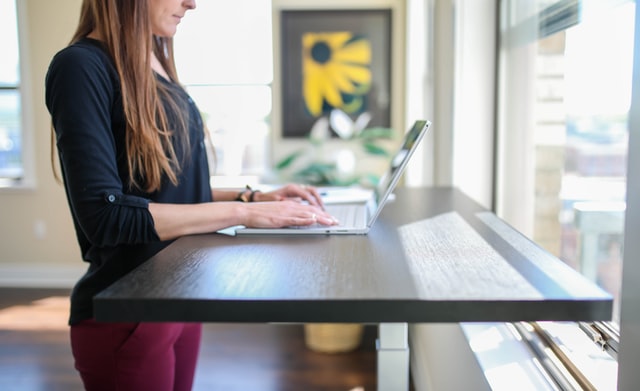Office Ergonomics: Preventing Work-Related Injuries Among Professional Women

While there are more women in the workforce than ever, it’s still largely a place designed with men in mind. According to the President of the National Safety Council, women are more likely to get hurt on the job because of their environment. Women are also more likely to experience injuries that could alter their lives forever, including problems that could trigger arthritis, carpal tunnel, sprains, and strains.
No matter your industry, it’s important to be diligent about your safety and well-being. One of the easiest and most effective ways to do that, especially for women, is to introduce more ergonomic practices and designs into the workplace. Doing so can reduce the risk of work-related injuries and create professional environments that are safer and more suitable for female employees.
Office ergonomics that consider gender-specific physiological needs can be extremely beneficial to businesses, and especially empowering to women. Whether you work in an office setting or you’re on your feet most of the day, advocating for safer and more comfortable work environments can enhance your well-being and productivity, and start to change the landscape of the working world, at large.
What Are Office Ergonomics?
Many people don’t think about ergonomics unless they’re looking at something like a new desk chair. While that’s a good place to start, there’s much more to understand about ergonomics and how it can impact your well-being.
According to the Associates for Women’s Medicine, ergonomics is the study of the work you do, the workplace environment you’re in, and the tools you use to do your job. The ideal workplace will have a setup for you that allows you to complete your work comfortably and safely. The focus of your workplace setup should include:
- How long you stay in one position;
- Light, noise, and temperature;
- How often you complete repeated motions each day;
- Whether the tools you need are set up correctly.
When your workstation is set up properly with ergonomics in mind, you’re less likely to experience headaches, eye strain, and muscle aches and pains in your back and neck.

How To Avoid Injuries With Ergonomics
In an office setting, you might not think about getting injured, but a lack of ergonomic furniture and tools can end up playing a long game with your health. Thankfully, you can avoid many injuries and a lot of pain by making sure you have the right tools in place.
Start with your chair. If you’re sitting for at least eight hours a day, you should have a chair that allows you to sit fully upright. Your knees should be at a 90-degree angle, and you should be looking directly at your work, not having to strain your neck up or down to see a computer screen.
Your desk should be set up so you don’t have to lean or twist to reach things multiple times a day. Keep your wrists straight instead of at an angle, and if you can’t quite reach comfortably, consider propping a pillow against the back of your chair to give you a bit more support.
In addition, things like sitting or standing tall, frequently changing your position, and taking frequent breaks to stretch or get active can all make a difference in how you feel while reducing the chance of getting injured.
Reduce Your Stress
While you may be focused on the actual ergonomics of your workstation to avoid injuries, it’s just as important to investigate the more mental aspects of your work and personal life that may be causing these physical injuries.
According to a 2021 Gallup “State of the Global Workplace” report, more than 57% of employees surveyed in the United States and Canada reported experiencing high stress and physical manifestations of this stress. This stress doesn’t have to originate in the workplace either. Working adults often have to juggle stressors in all facets of their lives.
There are errands to run, relationships to maintain, and financial stability to worry about. For many, stress originates in their financial well-being, especially if their work isn’t properly compensated. If you’re constantly worried about how you’re going to pay your bills, you won’t be able to concentrate at work, and may even notice a crick in your neck from keeping your shoulders tense all day.
The solution to address your physical manifestations of this stress is to discuss a raise or promotion with your employer or seek employment elsewhere. In the meantime, it’s important to prioritize your mental health along with your physical health in the following ways:
- Take breaks often in the work day;
- Build a budget to rely on during tough times;
- Build a new hobby for you to explore in your downtime;
- Reconnect with nature.
No matter your solution, checking in with yourself mentally and physically is the best way to relieve physical manifestations of your stress that could lead to a workplace injury.

Recovering From a Work-Related Injury
If you’ve already experienced an injury from too much strain and pain, it’s not too late to recover and move forward in healthier, more effective ways. If you plan on returning to the office, talk to your manager or employer about what can be done to create a safer environment. It’s your employer’s responsibility to make sure their team is free of health risks.
If you work from home, consider what you can do to transform your workspace into an area that prioritizes your safety and health.
This guest post was authored by Ainsley Lawrence
Ainsley Lawrence is a freelance writer who lives in the Northwest region of the United States. She has a particular interest in covering topics related to good health, balanced life, and better living through technology. When not writing, her free time is spent reading and researching to learn more about her cultural and environmental surroundings. You can follow her on Twitter @AinsleyLawrenc3
*******
Ms. Career Girl strives to provide valuable insights you can use. To see more from our columnists and guest authors, check these out! Or subscribe to our weekly email featuring our latest articles. We’re also present on Medium!

